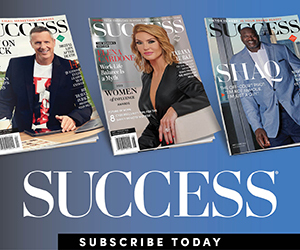I’ve had five babies in nine years, and after each one I’ve faced a long emotional and physical recovery. Between rebuilding muscles and babying old injuries, it’s been a tough journey. I’ve tried many self-improvement hacks and ideas to stay on track during these foggy postpartum months—online food logs, detailed exercise journals and more.
However, this most recent experience was different. After my last baby, I decided I needed to simplify, and then simplify some more. After all, with five kids and a full-time job, I deserved some self-grace, right? So, when I received the gift of a planner that had big boxes for each day, I simply jotted down my total minutes spent moving or doing something active in the corresponding box on each date.
At first, I started with a 5. I had moved for just five minutes during a short outdoor walk. However, the activity details weren’t in the log, just a simple number. The next day, I saw the planner on my desk and opened it to the current date. I asked myself, “What if today, the number was 10?” I walked again.
Now, 10 months postpartum, I feel stronger than ever. I have a calendar full of the total time I’ve moved each month on my desk. My only goal is to fill most boxes with something. After so many other logs and accountability processes failed, this method succeeded. Why?
- It’s simple. There’s no mental work involved with this type of logging.
- It’s visible. When I’m working, it’s a mainstay on my desk. It basically demands to be filled out.
- It’s worthwhile. It’s a goal I believe in, and it’s rooted in a bigger-picture mission I’m on—to have a healthy body and mind, for myself and my kids.
Turns out, I’m not the only person to optimize a simple hack for maximum benefits. Once I started paying more attention, I realized these self-improvement hacks were everywhere. They’re worth trying for anyone who wants to simplify their life but maximize their efficacy.
Here are some simple hacks for self-improvement that you can easily incorporate into your life.

Utilize phone calls for connection and to get stuff done
Make a phone call? Is this 1998? Why bother when we have email, social media, text and so forth?
Because a short call can lead to increased connection, productivity and even success in closing sales.
Need proof? Phone calls from nurses increase survival rates in patients after discharge. Empathetic phone calls from Meals on Wheels helped offset depression, loneliness and anxiety in single, homebound people during the COVID-19 pandemic. A variety of salespeople still count phone calls as their number one most successful sales tactic for a reason. Of course, it might take some practice.
After all, 76% of millennials feel anxiety when their phone rings. Gen Z might even think making a phone call is like someone asking them to use a fax machine. However, research supports giving it a try. It’s perhaps the most simple hack to build relationships and just get stuff done, both in business and life.
Your email inbox will thank you.
Keep a “win” log
Seattle-based narrative journalist and entrepreneur Wudan Yan shares a simple, tangible business hack with her coaching clients. She encourages them to use a notebook to jot down their business wins. They can either leave it on their desk or carry it around with them.
“The goal of the confidence log is to say, ‘I committed an act of bravery, and people said yes.’” She shares that for some, this means asking for a 50% raise. For others, it might be charging an additional fee when someone asks them to turn something in quickly.
She says, “Having the confidence log so close to you acts like a mirror, so the next time people think ‘I can’t ask for more,’ or ‘I can’t negotiate this,’ or ‘I can’t reach out to a Fortune 500 client,’ they have evidence that they’ve done a lot already.” She says that’s her clients’ fuel for their “next big thing” in business.
Make the first step short and doable
You know that thing you’ve been wanting to do? The one nagging at you when you get really quiet and try to figure out where you’re headed? You can make a plan, today, to get started on that.
Amy Goober, action coach and empty nester expert, shares a tip on TikTok that works in business planning and life planning. It sounds ridiculously simple because it is.
- Sit by yourself to think about where you are and where you want to go.
- Write it down. What do you want to improve or explore?
- Tune out the noise surrounding the “what-if” scenarios and logistics.
- Make a step-by-step plan.
- Take the first step of your plan, and make sure it lasts no longer than 30 minutes.
Since taking the first step of your plan can’t last longer than 30 minutes, that makes it much more doable. As the popular proverb by Lao Tzu goes, “The journey of a thousand miles begins with a single step,” so make sure you can fit it into a lunch break.
And here’s a writer’s note for those who struggle with that “tuning out the noise” step. Writers have long used the abbreviation “TK” to stand for something they’ll add later. It keeps the creative flow rolling while noting that more attention needs to be paid to a certain detail. Kate Winick, former editor and former senior director of social media at Peloton, shares more examples of how to try it on LinkedIn.
Use proximity to your advantage
If you always need a phone charger on your commute home from work, why is it on your bedside table? Julie Neale, life and leadership coach and founder of Mother’s Quest says, similarly, if the floss is by your sink and you can easily reach it, maybe you will. “I’ve learned that making things as easy as possible really matters,” she adds. It’s the same reason you’ll only find her taking her vitamins from an organizer.
Research has shown this works with much more than personal hygiene and wellness items. In one study, people were more likely to eat healthy, or unhealthy, based on the proximity of the foods closest to them. So, though it seems basic, if the candy bar is on your desk, as opposed to fruit and almonds, you’re more likely to eat it.
Whether you’re trying to double your profits this year, find some inner calm, or become more connected, there’s likely an incredibly simple self-improvement hack for building a path to get there right under your nose—kind of like your floss.
Photo by Bagus Production/Shutterstock.com



